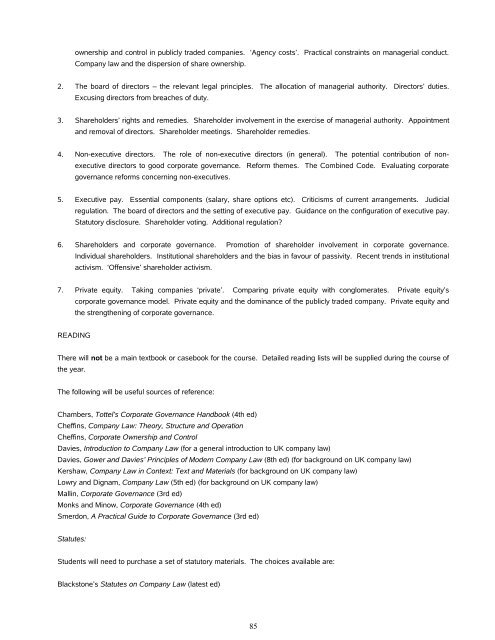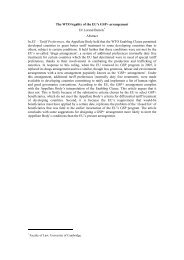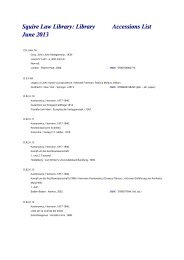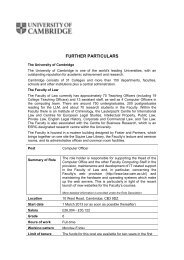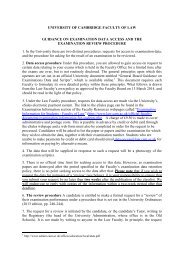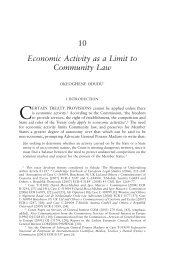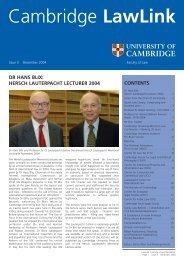G<strong>of</strong>f and Jones, The <strong>Law</strong> <strong>of</strong> Restitution (7th ed 2009)Chitty on Contracts (30th ed 2008) ch 29Further reading:Baloch, Unjust Enrichment and Contract (2009)Bant, The Change <strong>of</strong> Position Defence (2009)Beatson, The Use and Abuse <strong>of</strong> Unjust Enrichment (1991)Birks (ed), Laundering and Tracing (1995)Birks and Rose (eds), Lessons <strong>of</strong> the Swaps Litigation (2000)Birks and Pretto (eds), Breach <strong>of</strong> Trust (2002)Burrows (ed), Essays on the <strong>Law</strong> <strong>of</strong> Restitution (1991)Burrows and Rodger (eds), Mapping the <strong>Law</strong>: Essays in Honour <strong>of</strong> Peter Birks (2006)Chambers, Resulting Trusts (1997)Chambers, Mitchell and Penner, Philosophical Foundations <strong>of</strong> the <strong>Law</strong> <strong>of</strong> Unjust Enrichment (2009)Cornish, Nolan, O’Sullivan and Virgo (eds), Restitution: Past, Present and Future (1998)Dagan, The <strong>Law</strong> and Ethics <strong>of</strong> Restitution (2004)Degeling and Edelman (eds), Equity in Commercial <strong>Law</strong> (2005)Degeling and Edelman (eds), Unjust Enrichment in Commercial <strong>Law</strong> (2008)Edelman, Gain-Based Damages (2002)Edelman and Bant, Unjust Enrichment in Australia (2006)Getzler (ed), Modern <strong>Law</strong> <strong>of</strong> Real Property and Trusts - Essays for Edward Burn (2003)Giglio, The Foundation <strong>of</strong> Restitution for Wrongs (2007)Hedley, Restitution: Its Division and Ordering (2001)Hudson (ed), New Perspectives on Property <strong>Law</strong>, Obligations and Restitution (2004)Jaffey, The Nature and Scope <strong>of</strong> Restitution (2000)Johnston and Zimmermann (ed), Unjustified Enrichment (2002)Krebs, Restitution at the Crossroads: A Comparative Study (2001)Mitchell and Mitchell (eds), Landmark Cases in the <strong>Law</strong> <strong>of</strong> Restitution (2006)Neyers, McInnes and Pitel (eds), Understanding Unjust Enrichment (2004)Restitution <strong>Law</strong> Review (1993-date)Rickett and Grantham (eds), Structure and Justification in Private <strong>Law</strong> (2008)Rickett (ed), Justifying Private <strong>Law</strong> Remedies (2008)Robertson and Wu, The Goals <strong>of</strong> Private <strong>Law</strong> (2009)Rose (ed), Restitution and Banking <strong>Law</strong> (1998)Rose (ed), Restitution and Insolvency (2000)Rotherham, Proprietary Remedies in Context (2002)Rush, The Defence <strong>of</strong> Passing On (2006)Smith, The <strong>Law</strong> <strong>of</strong> Tracing (1997)Swadling (ed), The Limits <strong>of</strong> Restitutionary Claims: A Comparative Analysis (1997)Swadling and Jones (ed), The Search for Principle: Essays for Lord G<strong>of</strong>f <strong>of</strong> Chieveley (1999)Swadling (ed), The Quistclose Trust (2004)PAPER 10. CORPORATE GOVERNANCE1. Overview <strong>of</strong> key corporate governance matters. Corporate governance as a topic for study. Defining corporategovernance. Emergence <strong>of</strong> corporate governance as an important issue. Tiers <strong>of</strong> regulation. The separation <strong>of</strong>84
ownership and control in publicly traded companies. ‘Agency costs’. Practical constraints on managerial conduct.Company law and the dispersion <strong>of</strong> share ownership.2. The board <strong>of</strong> directors – the relevant legal principles. The allocation <strong>of</strong> managerial authority. Directors’ duties.Excusing directors from breaches <strong>of</strong> duty.3. Shareholders’ rights and remedies. Shareholder involvement in the exercise <strong>of</strong> managerial authority. Appointmentand removal <strong>of</strong> directors. Shareholder meetings. Shareholder remedies.4. Non-executive directors. The role <strong>of</strong> non-executive directors (in general). The potential contribution <strong>of</strong> nonexecutivedirectors to good corporate governance. Reform themes. The Combined Code. Evaluating corporategovernance reforms concerning non-executives.5. Executive pay. Essential components (salary, share options etc). Criticisms <strong>of</strong> current arrangements. Judicialregulation. The board <strong>of</strong> directors and the setting <strong>of</strong> executive pay. Guidance on the configuration <strong>of</strong> executive pay.Statutory disclosure. Shareholder voting. Additional regulation?6. Shareholders and corporate governance. Promotion <strong>of</strong> shareholder involvement in corporate governance.Individual shareholders. Institutional shareholders and the bias in favour <strong>of</strong> passivity. Recent trends in institutionalactivism. ‘Offensive’ shareholder activism.7. Private equity. Taking companies ‘private’. Comparing private equity with conglomerates. Private equity’scorporate governance model. Private equity and the dominance <strong>of</strong> the publicly traded company. Private equity andthe strengthening <strong>of</strong> corporate governance.READINGThere will not be a main textbook or casebook for the course. Detailed reading lists will be supplied during the course <strong>of</strong>the year.The following will be useful sources <strong>of</strong> reference:Chambers, Tottel’s Corporate Governance Handbook (4th ed)Cheffins, Company <strong>Law</strong>: Theory, Structure and OperationCheffins, Corporate Ownership and ControlDavies, Introduction to Company <strong>Law</strong> (for a general introduction to UK company law)Davies, Gower and Davies’ Principles <strong>of</strong> Modern Company <strong>Law</strong> (8th ed) (for background on UK company law)Kershaw, Company <strong>Law</strong> in Context: Text and Materials (for background on UK company law)Lowry and Dignam, Company <strong>Law</strong> (5th ed) (for background on UK company law)Mallin, Corporate Governance (3rd ed)Monks and Minow, Corporate Governance (4th ed)Smerdon, A Practical Guide to Corporate Governance (3rd ed)Statutes:Students will need to purchase a set <strong>of</strong> statutory materials. The choices available are:Blackstone’s Statutes on Company <strong>Law</strong> (latest ed)85
- Page 2 and 3:
ContentsGeneral InformationOfficers
- Page 4 and 5:
Settlement of International Dispute
- Page 6 and 7:
Faculty AdministrationFaculty Offic
- Page 8 and 9:
The Faculty of LawLaw has been stud
- Page 10 and 11:
The LLM Degree. This degree is awar
- Page 12 and 13:
Opening Hours:Full Term: Monday to
- Page 14 and 15:
Rules Made by the Information Strat
- Page 16 and 17:
The Lauterpacht Centre for Internat
- Page 18 and 19:
Centre for Corporate and Commercial
- Page 20 and 21:
Cambridge Socio-Legal GroupThe Camb
- Page 26 and 27:
Dates of Faculty Board Meetings7 Oc
- Page 28 and 29:
Proceed with caution in reaching fo
- Page 30 and 31:
Faculty CommunicationEach year, the
- Page 32 and 33:
Law Tripos Part IA. A candidate for
- Page 34 and 35: Prizes. The following prizes may be
- Page 36 and 37: PAPER 2. CONSTITUTIONAL LAWA. The a
- Page 38 and 39: Oliver, Constitutional Reform (2003
- Page 40 and 41: Hedley, Tort (6th ed 2008)Weir, An
- Page 42 and 43: 3. Trusts and co-ownership: Concurr
- Page 44 and 45: Brownlie, Principles of Internation
- Page 46 and 47: Elliott, Constitutional Foundations
- Page 48 and 49: Contract: covenant and debt; assump
- Page 50 and 51: Statutes:Blackstone’s Statutes on
- Page 52 and 53: For reference:Birks and Pretto (ed)
- Page 54 and 55: Foster, EU Legislation (2010-2011)B
- Page 56 and 57: PAPER 42. INTELLECTUAL PROPERTY1. I
- Page 58 and 59: 2. Property torts (conversion and t
- Page 60 and 61: (iii)Causation4. Contracts in Engla
- Page 62 and 63: Rawls, Political LiberalismRawls, J
- Page 64 and 65: Rodger and McCulloch, The UK Compet
- Page 66 and 67: Law Commission, Renting Homes: The
- Page 68 and 69: Human Rights Case DigestHuman Right
- Page 70 and 71: 3. Title at common law and in equit
- Page 72 and 73: Exemption from Professional Examina
- Page 74 and 75: Paper application available to down
- Page 76 and 77: Form of Examination and Designation
- Page 78 and 79: ‘Open Book’ Papers. Where a pap
- Page 80 and 81: LLM : Syllabuses and Lists of Recom
- Page 82 and 83: ased upon one or two leading cases,
- Page 86 and 87: Butterworths’ Company Law Handboo
- Page 88 and 89: 2. The EU’s system for human righ
- Page 90 and 91: the context of environmental protec
- Page 92 and 93: European Competition Law Review (EC
- Page 94 and 95: Crawford, The Treatment of Combatan
- Page 96 and 97: Douglas, The International Law of I
- Page 98 and 99: Unger, Free Trade Reimagined (2007)
- Page 100 and 101: 3. Sceptics and Critics I4. Sceptic
- Page 102 and 103: The course provides an opportunity
- Page 104 and 105: (iv)(v)(vi)(vii)Is either utilitari
- Page 106 and 107: Reiman, ‘Justice, Civilization, a
- Page 108 and 109: Gardner, Introduction to the Law of
- Page 110 and 111: 1. Types of theoretical analysis an
- Page 112 and 113: 2. Specific fieldsTopics to be sele
- Page 114 and 115: The LLM (one-year taught postgradua
- Page 116 and 117: As part of the requirements for the
- Page 118 and 119: Teaching Members of the Faculty of
- Page 120 and 121: MC Elliott, MA, PhD (Cantab); St Ca
- Page 122 and 123: RA Melikan, BA (Mich), JD, MA (Chi)
- Page 124 and 125: BD Sloan, MA, LLM (Cantab); King’
- Page 126 and 127: Law Teachers in the Department of L
- Page 128 and 129: Murray Edwards College. Dr S Turenn


